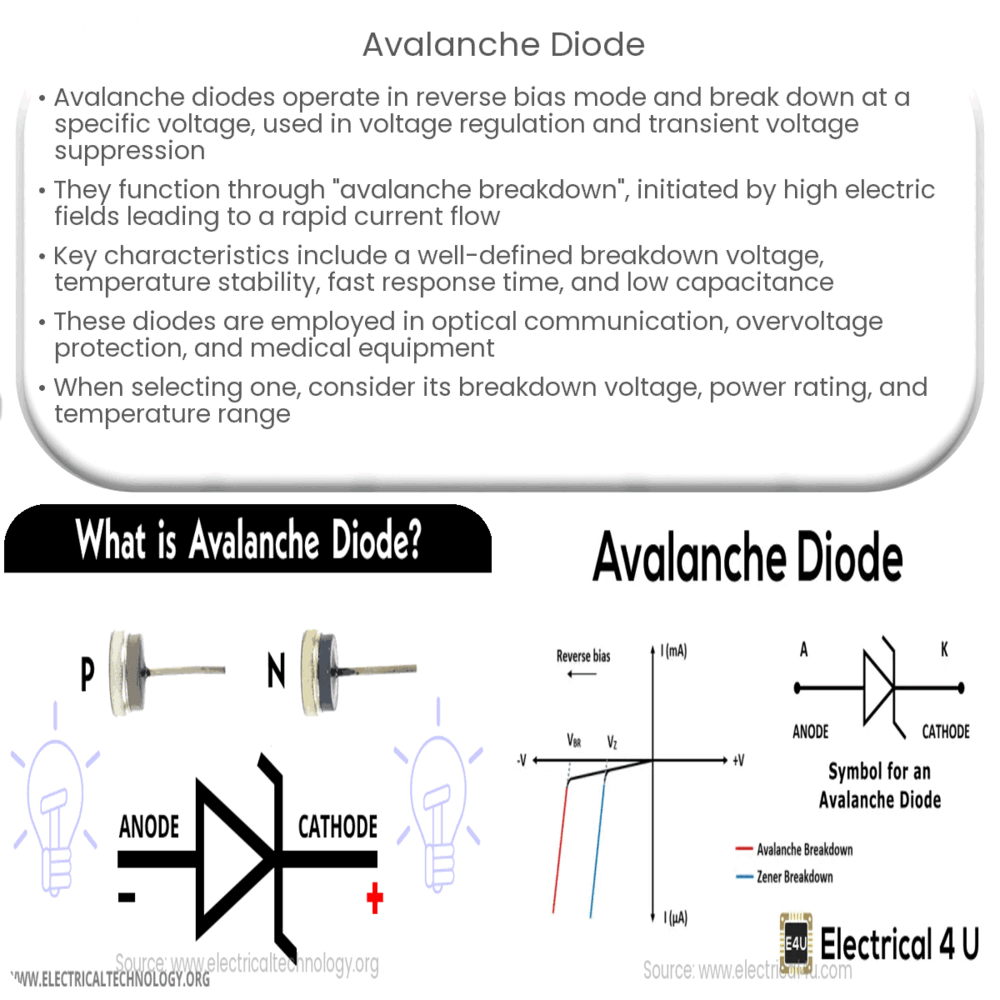An avalanche diode is a semiconductor device designed for reverse bias operation, known for its sharp breakdown voltage, temperature stability, and fast response in various applications.

Avalanche Diode: An Overview
Introduction
Avalanche diodes are semiconductor devices that operate in reverse bias mode and are specifically designed to break down at a precise voltage. These diodes are widely used in a variety of applications, such as voltage regulation, transient voltage suppression, and voltage reference. This article will explore the fundamentals of avalanche diodes, including their operation, characteristics, and applications.
Operation Principle
Avalanche diodes function by utilizing a process called “avalanche breakdown. This occurs when the diode’s reverse-biased junction experiences a high electric field. At this point, the minority carriers in the diode gain enough kinetic energy to generate new electron-hole pairs via impact ionization, resulting in a rapid multiplication of carriers. This ultimately leads to a large current flow through the device, even though it is reverse-biased. The breakdown voltage, which is the voltage at which the avalanche breakdown occurs, is a critical parameter of avalanche diodes and is carefully controlled during the manufacturing process.
Characteristics
Avalanche diodes exhibit several key characteristics, including:
- Sharp Breakdown Voltage: The breakdown voltage of an avalanche diode is sharp and well-defined. This allows the diode to be used in applications that require precise voltage regulation or voltage reference.
- Temperature Stability: Unlike other diodes, the breakdown voltage of an avalanche diode remains relatively stable with changes in temperature. This makes them suitable for use in environments with fluctuating temperatures.
- Fast Response Time: Avalanche diodes have a rapid response to voltage changes, which is beneficial for transient voltage suppression applications.
- Low Capacitance: The capacitance of an avalanche diode is generally lower compared to other diodes, such as Zener diodes, making them ideal for high-frequency applications.
Types of Avalanche Diodes
There are several types of avalanche diodes, each with its own specific characteristics and applications. Some common types include:
- Avalanche Photodiode (APD): APDs are photosensitive devices that can detect low-intensity light signals. They are often used in optical communication systems, LIDAR, and medical equipment due to their high sensitivity and speed.
- Transient Voltage Suppression (TVS) Diode: TVS diodes are designed to protect sensitive electronic circuits from voltage spikes and transient overvoltages. They are commonly used in surge protection applications, such as power supply filtering and electrostatic discharge protection.
- Voltage Reference Diode: These diodes are specifically designed to maintain a stable reference voltage, making them suitable for use in voltage regulation circuits and power supplies.
Applications of Avalanche Diodes
Avalanche diodes find use in a wide range of applications due to their unique properties. Some common applications include:
- Overvoltage Protection: Avalanche diodes, particularly TVS diodes, are used to protect sensitive electronic components from voltage spikes and transient overvoltages that can cause damage or reduce their lifespan.
- Voltage Regulation: Voltage reference diodes provide a stable reference voltage, making them an ideal choice for use in voltage regulation circuits and power supplies. They help maintain a constant output voltage despite fluctuations in input voltage or load current.
- Optical Communication: Avalanche photodiodes (APDs) are used in high-speed optical communication systems, such as fiber-optic networks, to convert incoming light signals into electrical signals with minimal signal degradation.
- Distance Measurement: APDs are commonly used in LIDAR systems for distance measurement, navigation, and obstacle detection in autonomous vehicles, robotics, and drones.
- Medical Equipment: APDs are employed in various medical devices, such as positron emission tomography (PET) scanners and optical coherence tomography (OCT) systems, to provide high-resolution imaging for diagnostic purposes.
Selecting an Avalanche Diode
When selecting an avalanche diode for a specific application, several factors must be considered, including:
- Breakdown Voltage: Choose an avalanche diode with a breakdown voltage that meets the requirements of your application. Ensure that the breakdown voltage is sufficient to handle the expected voltage levels in the system.
- Power Rating: The power rating of the diode should be able to handle the power dissipation that occurs during operation. Exceeding the power rating can lead to device failure or reduced lifespan.
- Response Time: For applications that require fast transient response, such as surge protection, choose an avalanche diode with a rapid response time.
- Temperature Range: Ensure that the avalanche diode can operate within the expected temperature range of your application. Select a diode with a stable breakdown voltage over the entire temperature range for optimal performance.
- Package Type: Consider the package type of the diode based on the available space and mounting requirements in your design.
Conclusion
Avalanche diodes are versatile semiconductor devices that offer a wide range of benefits, such as sharp breakdown voltage, temperature stability, and fast response time. These characteristics make them suitable for various applications, including overvoltage protection, voltage regulation, optical communication, and distance measurement. When selecting an avalanche diode, it is essential to consider factors such as breakdown voltage, power rating, response time, temperature range, and package type to ensure optimal performance in your specific application.

